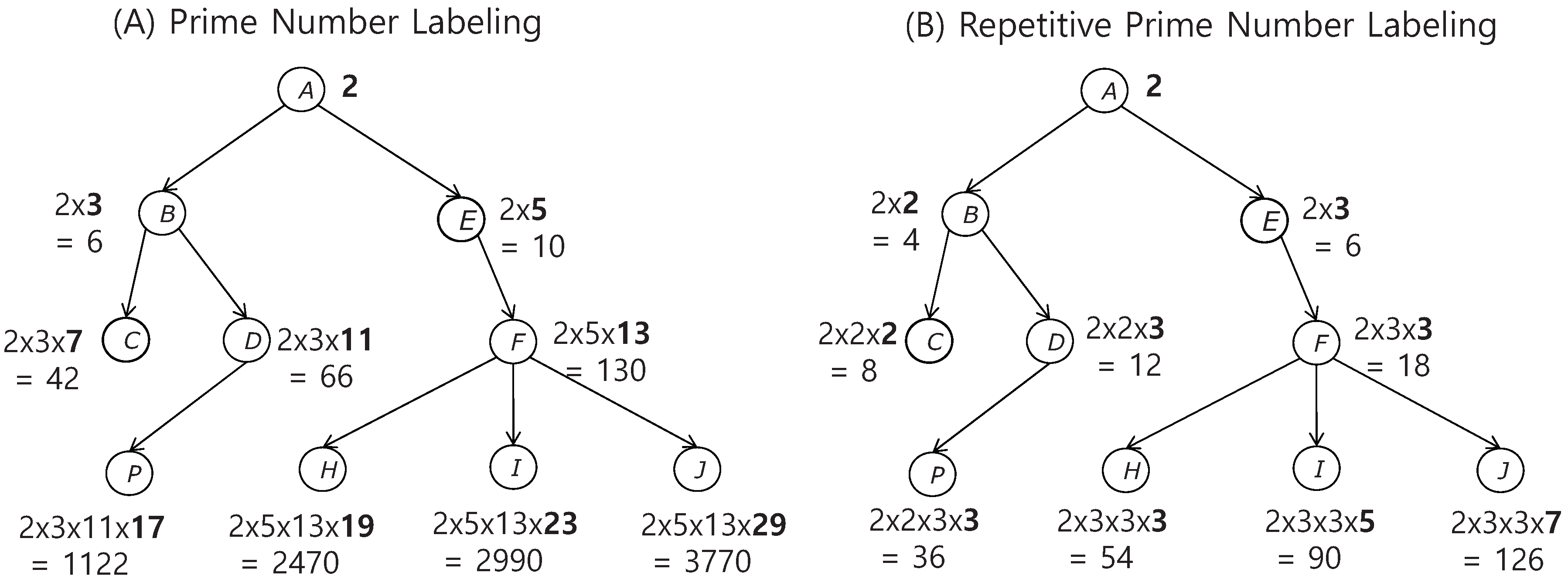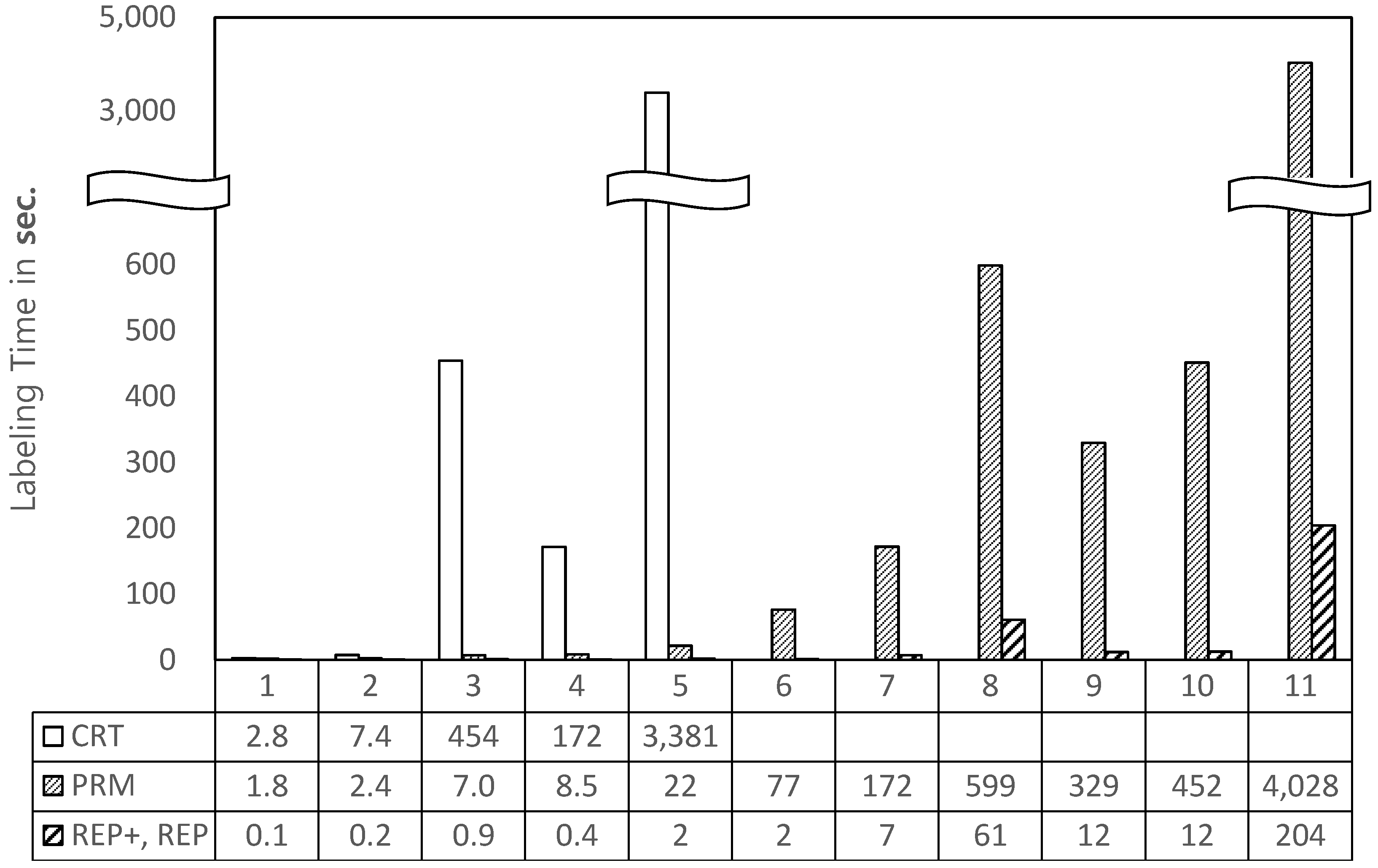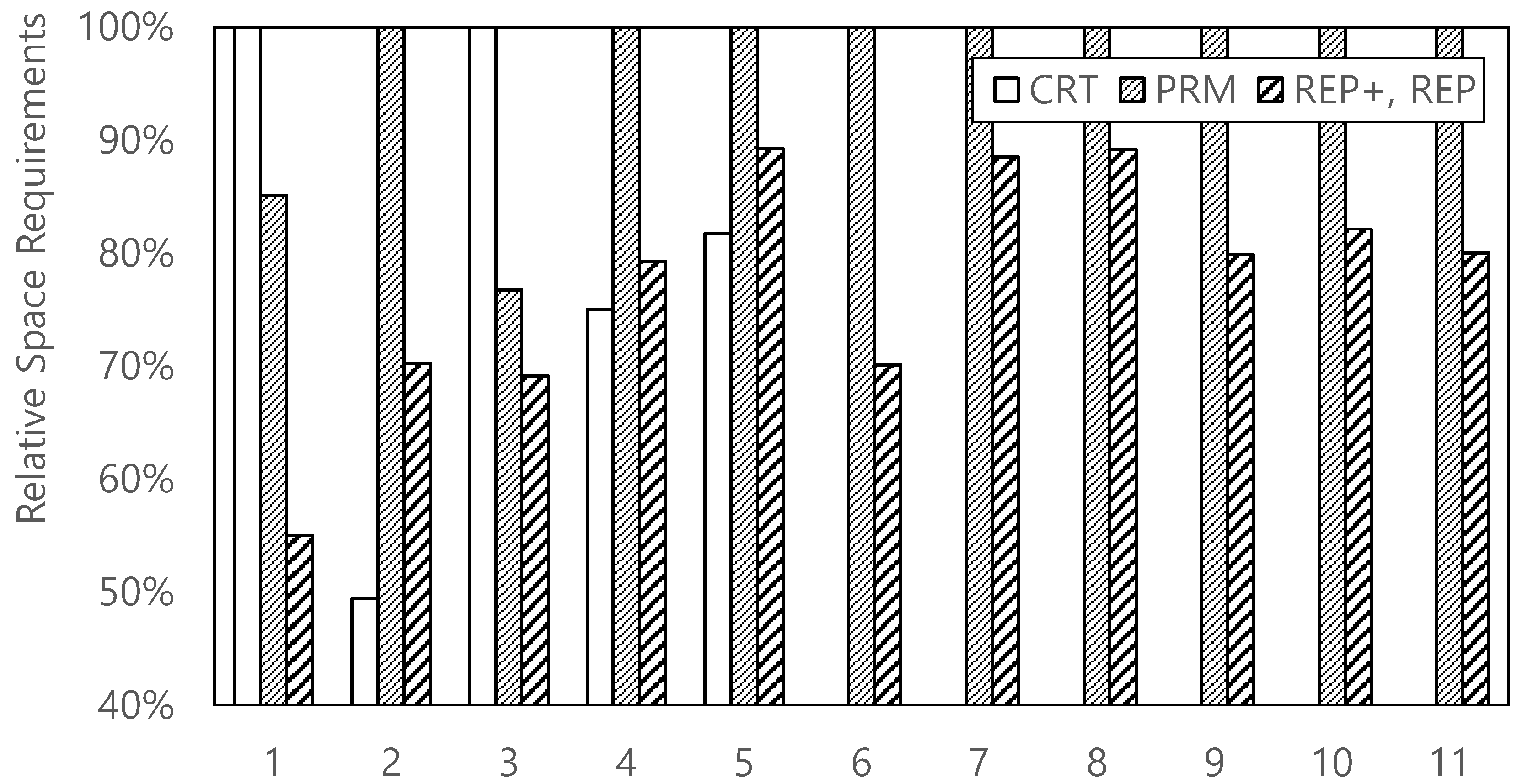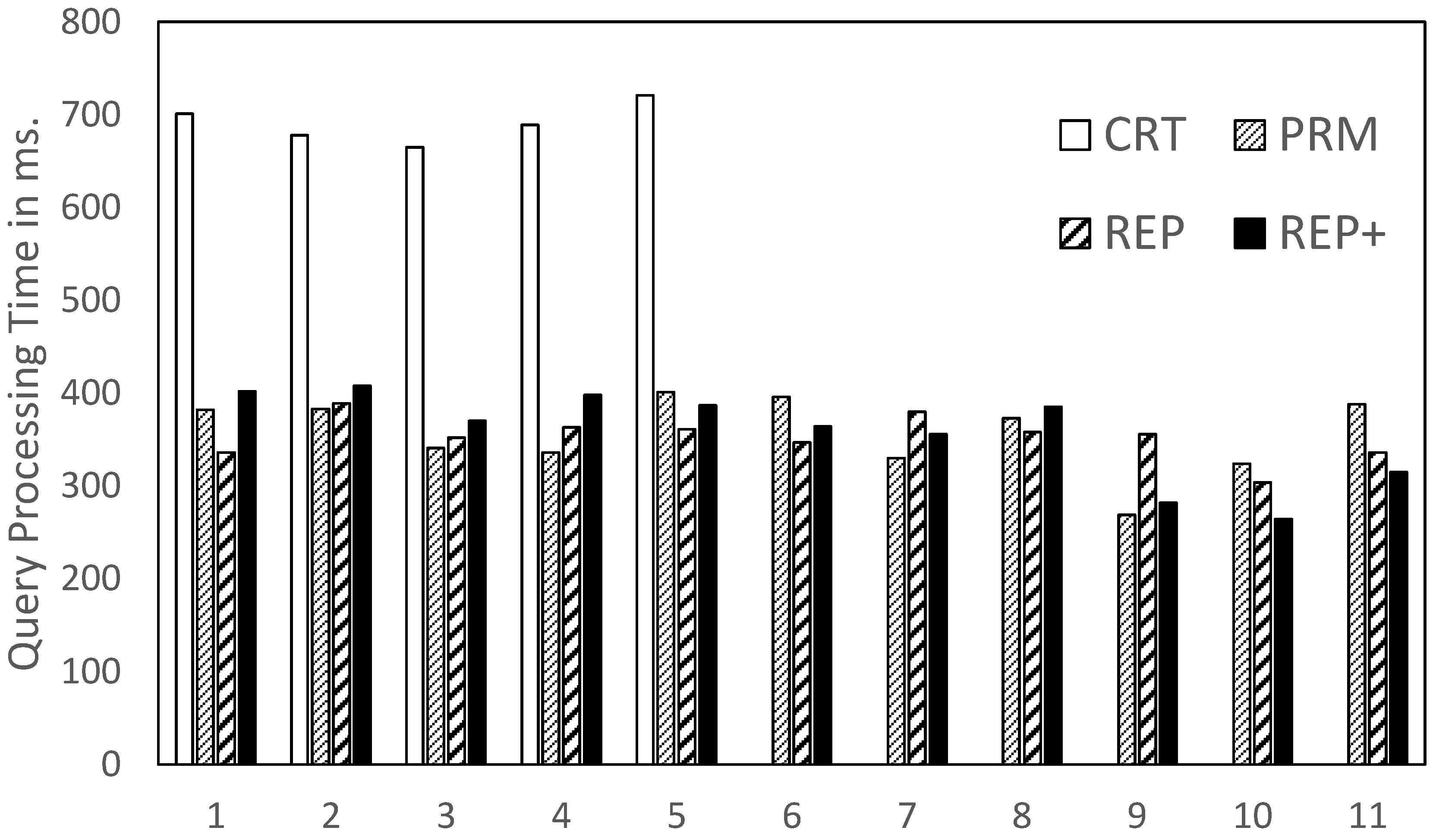1. Introduction
A vast amount of tree-structured data on diverse domains is available in eXtensible Markup Language (XML) files on the Web, such as SwissProt (protein sequence database), DBLP (computer science bibliography), and Treebank (tagged sentences). A query that determines whether there exists a path between the two nodes of a given pair (source and target) is an important one for trees. It can also be regarded as a reachability or ancestor–descendant query. A straightforward manner to address it is tree traversal, starting from the source node and then visiting intermediate nodes until arriving at the target node. However, it is not feasible to use this method in the case of large trees.
To avoid visiting intermediate nodes, labeling schemes have been proposed [
1]. Existing works are classified into containment-based [
2,
3], prefix-based [
4,
5], and prime number labeling schemes. In this paper, we focus on a prime number labeling scheme that does not require all the nodes to be re-labeled when some nodes are updated. An earlier study on a prime number labeling scheme was reported in [
6]. In this scheme (hereafter,
PRM), each node is assigned a globally unique prime number, called a
self label. The node label is then recursively computed by multiplying its
self label and its parent node’s label. The pair of two nodes is reachable if the target node label is divisible by the source node label. An approach has been proposed to utilize the MapReduce framework in order to do prime number labeling of massive XML data [
7]. The schemes’ shortcomings are apparent when the number of nodes becomes very large—the size of
self labels increases as well. In addition, they did not consider the performance of answering reachability queries.
Attempts to reuse
self labels were made. In [
8,
9], a repetitive prime number labeling scheme (hereafter,
REP) was described that reuses prime numbers inherited from parents. In [
10], the order of ancestors’
self labels is encoded based on the Chinese Remainder Theorem (hereafter,
CRT). A drawback of these approaches is that their inefficient method for performing reachability tests significantly reduces their usability in the case of large datasets. In this paper, we propose an efficient method for answering reachability queries in
REP.
2. Repetitive Prime Number Labeling Scheme
In this section, REP is explained, and then, we explain the drawbacks related to its inefficient method for performing reachability tests. Let v and w be nodes in a tree. If an edge exists, then v is the parent of w. We denote by the parent node of w. Furthermore, w is reachable from v if there exists a sequence of nodes starting at v and ending at w, where consecutive node pairs in the sequence are in edges. In REP, each node is assigned a prime number, called a self label.
Definition 1. Self Label: is the self label of a node v such that is the -th prime number, wherewhere is the sibling order starting from 0
. The 1
-th prime number is 2
, which means that is 2
if v is a root. Note that a
self label in PRM [
6] is a globally unique prime number, whereas in REP,
self labels are locally unique prime numbers within sibling nodes. We now provide the definition of the label of a node.
Definition 2. Node Label: is the label of a node v, which is a composite number computed as Lemma 1. Given a node v, is equal to , where is the largest prime factor of .
(B) in
Figure 1 depicts an illustrative example labeled by Definition 2. For example,
is computed by multiplying
by
. A tree-labeling algorithm for this scheme is outlined in Algorithm 1.
| Algorithm 1 Labeling |
- 1:
procedure AssignLabels(T,p) ▹ T is a tree and p is a parent node (the root for the first-time call) - 2:
for the i-th child node c of p in T do - 3:
the i-th next prime number from ▹ Definition 1 - 4:
▹ Definition 2 - 5:
AssignLabels(T,c) - 6:
end for - 7:
end procedure
|
In [
8], a prime factorization method to answer a reachability query in REP was described. Both labels of the given two nodes must be prime factored; subsequently, prefix matching is performed against the two prime factor sequences. For example, referring to (B) in
Figure 1,
H is not reachable from
D as
is not prefix-matched in
. On the other hand,
H is reachable from
E as
is a prefix. We argue that prime factorization is an expensive task, which led us to devise a more efficient method of answering reachability queries, as explained in the next section.
3. Improving on Answering Reachability Queries
We observed that if a label is not divisible by the other label, it is not reachable. Referring to (B) in
Figure 1, for example,
is not divisible by
and
H is not a descendant of
D. Even if these nodes have the same
self label 3, they differ in terms of their ancestor nodes’
self labels, as in the case of
and
. This observation allows us to devise a simpler method of making decisions for unreachable pairs, which is proved in Theorem 1.
Theorem 1. If is not 0, then v is not a descendant of w.
Proof. In a proof by contrapositive, first we assume that v is a descendant of w. By Definition 2, because the label is computed recursively, contains the label of its parent node as a factor, contains , and so on. This indicates that contains as a factor, that is, is divisible by . ☐
However, the inverse of Theorem 1 does not always hold, i.e., if
is 0, then
v is a descendant of
w. Consider the two node pairs (
E,
H) and (
E,
P) in (B) of
Figure 1.
is divisible by
and
H is a descendant of
E. This is trivial, because a child node label must have its parent node label as a factor. On the other hand,
is also divisible by
, but
P is indeed not a descendant of
E. This occurs because both have the same
self labels and their ancestor nodes also have the same
self labels (i.e.,
). Definition 2 leads us to consider the quotient of
and
. If
P is a descendant of
E, every factor of the quotient must be larger than or equal to
, because the
self label of a child node is larger than or equal to any
self labels of its parent nodes. This is not true in this case, which means that
P is not a descendant of
E. We formally define this observation in Theorem 2.
Theorem 2. Let be the smallest prime factor of a number . Let be the quotient of . Assume that is 0. If , then v is a descendant of w; otherwise, v is not a descendant of w.
Proof. In a direct proof, because
is 0, we have
There exist two cases for
. Assume that
is a prime number. Consider the case (
). It is trivial that
and
must be
by the antecedent and Property 1. Therefore, Equation (
1) can be rewritten as
. By Definition 2, we have
, which proves the consequent. Now, consider the case (
). Because
is the largest factor of
(by Property 1) and is larger than
,
is the largest factor of
, which means that
. We now rewrite Equation (
1) as
. By Definition 2, there exists a node
such that
. Consider Theorem 1. Because
mod
is not 0,
is not a descendant of
w. Therefore,
v is not a descendant of
w, which proves the consequent.
Assume the second case for Equation (
1), where
is a composite number. We consider
and then replace
in Equation (
1) as follows:
where
such that
. If
is still a composite number,
in Equation (
3) can further be rewritten as
, where
, such that
. This process can be continued until we have a node label
. Now, assume a node
. Applying the same proof as above for the case where
is a prime, we are able to determine the ancestor-descendant relationships between
r and
w. If
r is determined to be a descendant of
w,
v must be a descendant of
w, because
v is a descendant of
r. If
r is determined not to be a descendant of
w,
v must not be a descendant of
w because every descendant of
r is not a descendant of
w. ☐
We devised an algorithm based on the theorems to test the reachability of two ordered nodes, which is outlined in Algorithm 2. In implementation level, we used BigInteger class in Java to handle very large integers. An iterative algorithm was implemented to realize line 7–12. The algorithm begins with the first prime factor of . We check if x is larger than . If so, the algorithm terminates and returns FALSE (line 9). Otherwise, we compute by iteratively dividing with x. In other words, is obtained by removing all prime factors x in (e.g., if and then ). We move x to the next prime factor (e.g., 3) and repeat the above process until x is smaller than in k-th iteration. It returns TRUE (line 11) if the iteration finishes.
| Algorithm 2 Querying |
- 1:
procedure IsReachable() ▹ and are node labels - 2:
- 3:
if then ▹ Theorem 1 - 4:
return FALSE - 5:
end if - 6:
- 7:
the largest prime factor of - 8:
if then ▹ Theorem 2 - 9:
return FALSE - 10:
else - 11:
return TRUE - 12:
end if - 13:
end procedure
|
4. Evaluation
Since in our study we focused on a prime number-based labeling scheme, containment-based and prefix-based approaches are beyond the scope of this paper. Experiments were conducted to compare our approach (
REP+) with
PRM [
6],
REP [
8], and
CRT [
10]. Note that
REP+ and
REP employ the same labeling schema, called
REP, but different reachability test methods. The
Section 4.1 and
Section 4.2 are intended to convince that
REP is the state-of-the-art approach in the area of prime number labeling of trees. Our contribution is to improve on reachability query processing of
REP which is demonstrated in
Section 4.3. The experiments were performed on a machine with a 2.6 GHz CPU and 128 GB RAM. XML datasets were obtained from [
11], with varied numbers of nodes, fanouts, and depths (see
Table 1). The experimental results were averaged over five runs.
4.1. Labeling Time
Figure 2 depicts the labeling time for each dataset. Because a substantial amount of time was spent by
CRT on smaller datasets, we omit its results for larger datasets. In all cases,
REP+, and
REP, outperformed
PRM and
CRT. Notable results were observed for large datasets, such as
Treebank_e,
SwissProt, and
psd7003. As the time expended by
PRM increased exponentially, the time expended by
REP+ increased gradually. This occurred because
PRM assigned larger prime numbers, and thus, additional time was required to determine the next prime number.
REP+ uses much smaller prime numbers because it reuses them.
CRT also reuses prime numbers; however, it considers every
self label of ancestor nodes, which significantly reduces its speed.
The performance results for dblp, which are poorer than the results for the larger dataset Treebank_e, are noteworthy. We observe that dblp has the largest max fanout, which means that there exists a node with a large number of child nodes. In REP+, the existence of a large number of sibling nodes is likely to increase the size of the prime numbers.
4.2. Space Requirements
Figure 3 shows a comparison of the space requirements of the approaches. For all datasets,
REP+ requires less space than
PRM.
CRT produced better results than
REP+ for some datasets; however, this is not a concern, because the labeling process is too slow to take advantage of the lower space requirements. It may be interesting to analyze datasets such as
SigmodRecord,
mondial-3.0, and
nasa. We observed that these datasets have larger average depths and smaller max fanouts than the others (see
Table 1). Because
REP+ reuses the prime numbers of the parent nodes, a smaller fanout of a certain node could lead to its grandchild nodes beginning with smaller
self labels. Meanwhile, in
REP+, a taller tree (e.g.,
Treebank_e) does not necessarily mean that leaf nodes have larger prime numbers. Assume an extreme case of a leftist tree.
REP+ uses only a prime number 2, while
PRM uses as many prime numbers as the number of nodes. For datasets such as
partsupp,
orders,
lineitem, and
dblp,
REP+ provides a saving in space of only
as compared to
PRM. These datasets show large max fanouts.
4.3. Query Processing Time
We randomly selected 1000 TRUE (reachable) and FALSE (non-reachable) node pairs from each dataset. The query processing time was measured to be the total time required to determine the reachability of 1000 node pairs.
For TRUE pairs (
Figure 4),
CRT showed the worst performance, as it requires prime factorization and a comparison of all remainders. The other approaches showed a similar performance. However, for the larger datasets, such as
SwissProt and
psd7003,
REP+ showed the best performance. The reason is that, as already shown in the previous section, the space requirements of
REP+ are the smallest, which renders the node labels smaller than those of other labeling schemes.
For FALSE pairs (
Figure 5),
REP showed the worst performance. The prime factorization and prefix matching of prime number sequences required by
REP reduces its speed. Note that there is a big performance difference between
REP and
REP+, which employ the same labeling scheme. Consider line 2 in Algorithm 2. In
REP+, if a label is not divisible by the other label, this signifies a FALSE pair. No additional operations are required for FALSE pairs, which allows
REP+ to be much faster than
REP. That is,
REP+ immediately terminates when the remainder is zero. It makes
REP+ to be more efficient than
REP in terms of CPU time. Meanwhile,
CRT is faster than
REP because
CRT stores
parent labels and
self labels separately, whereas
REP stores only one composite number. Thus,
CRT often has smaller number labels than
REP, which reduces query processing time.
Considering both TRUE and FALSE pairs, PRM is the only method that is comparable to REP+. PRM requires a single division operation for both TRUE and FALSE pairs, and is the fastest of the prime number labeling approaches thus far. Nevertheless, it was slower than REP+ for the larger datasets. This is because REP+ has smaller labels than PRM, which can be seen in its space requirements. This leads us to regard REP+ as a scalable approach. Moreover, since REP+ also outperforms PRM in terms of labeling time and space requirements, REP+ should be considered the most efficient approach overall.
5. Conclusions
We proposed an efficient method of answering reachability queries in a state-of-the-art prime number labeling scheme for XML data. Our contribution is that we devised a novel algorithm to determine the structural relationships between two nodes. We showed experimentally that our approach is faster than existing approaches. However, the proposed method failed to show better performance for TRUE pairs. It might be interesting to devise a faster way to determine reachability of TRUE pairs. We plan to design and implement an efficient mechanism to address update issues when there are insertions and deletions of nodes in a tree. In addition, we will devise a distributed algorithm to label XML datasets.
Author Contributions
D.-H.I. conceived the problem and supervised the whole research work; T.L. figured out some points that helped J.A. write the theorems; T.L. revised the theorems; J.A. implemented the algorithm and performed the experiments; J.A., T.L. and D.-H.I. wrote the paper.
Funding
This work was supported by the National Research Foundation of Korea(NRF) grant funded by the Korea government(MSIT) (No. NRF-2017R1C1B1003600) and Institute for Information & Communications Technology Promotion(IITP) grant funded by the Korea government(MSIP) (No. R0113-15-0005, Development of a Unified Data Engineering Technology for Largescale Transaction Processing and Real-Time Complex Analytics).
Conflicts of Interest
The authors declare no conflict of interest.
References
- Klaib, A.; Lu, J. Investigation into Indexing XML Data Techniques. In Proceedings of the International Conference on Internet Computing and Big Data, Kuala Lumpur, Malaysia, 17–19 November 2014. [Google Scholar]
- Xu, L.; Bao, Z.; Ling, T.W. A dynamic labeling scheme using vectors. In Database and Expert Systems Applications; Springer: Berlin, Germany, 2007. [Google Scholar]
- Li, C.; Ling, T.W. QED: A novel quaternary encoding to completely avoid re-labeling in XML updates. In Proceedings of the 14th ACM International Conference on Information and Knowledge Management, Bremen, Germany, 31 October–5 November 2005. [Google Scholar]
- Xu, L.; Ling, T.W.; Wu, H.; Bao, Z. DDE: From dewey to a fully dynamic XML labeling scheme. In Proceedings of the 2009 ACM SIGMOD International Conference on Management of Data, Providence, RI, USA, 29 June–2 July 2009. [Google Scholar]
- Tatarinov, I.; Viglas, S.D.; Beyer, K.; Shanmugasundaram, J.; Shekita, E.; Zhang, C. Storing and querying ordered XML using a relational database system. In Proceedings of the 2002 ACM SIGMOD International Conference on Management of Data, Madison, WI, USA, 3–6 June 2002. [Google Scholar]
- Wu, X.; Lee, M.L.; Hsu, W. A prime number labeling scheme for dynamic ordered XML trees. In Proceedings of the 20th International Conference on Data Engineering, Boston, MA, USA, 2 April 2004. [Google Scholar]
- Ahn, J.; Im, D.H.; Lee, T.; Kim, H.G. Parallel Prime Number Labeling of Large XML Data Using MapReduce. In Proceedings of the 2016 6th International Conference on IT Convergence and Security (ICITCS), Prague, Czech Republic, 26–29 September 2016; pp. 1–2. [Google Scholar] [CrossRef]
- Sun, D.H.; Hwang, S.C. A Labeling Methods for Keyword Search over Large XML Documents. J. KIISE (Korean Inst. Inf. Sci. Eng.) 2014, 41, 699–706. [Google Scholar] [CrossRef]
- Ahn, J.; Im, D.H.; Lee, T.; Kim, H.G. A dynamic and parallel approach for repetitive prime labeling of XML with MapReduce. J. Supercomput. 2017, 73, 810–836. [Google Scholar] [CrossRef]
- Morozov, S.; Saiedian, H.; Wang, H. Reusable Prime Number Labeling Scheme for Hierarchical Data Representation in Relational Databases. J. Comput. Inf. Technol. 2014, 22, 31–44. [Google Scholar] [CrossRef][Green Version]
- University of Washington. XMLData Repository. Available online: http://aiweb.cs.washington.edu/research/projects/xmltk/xmldata/ (accessed on 17 March 2018).
© 2018 by the authors. Licensee MDPI, Basel, Switzerland. This article is an open access article distributed under the terms and conditions of the Creative Commons Attribution (CC BY) license (http://creativecommons.org/licenses/by/4.0/).











